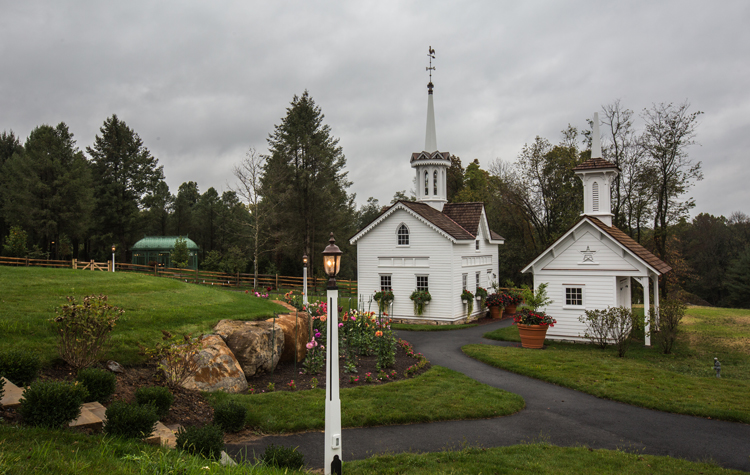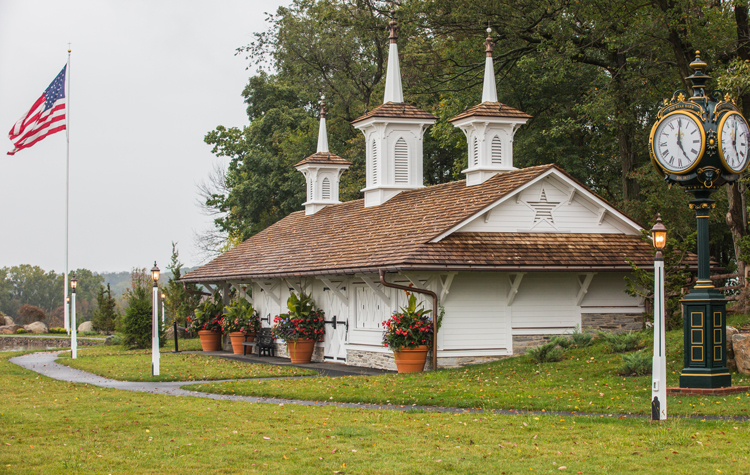The majestic Gothic Revival Star Barn has been a Pennsylvania landmark since 1877 and is one of the most photographed and artist-painted barns in America. Its unique star-shaped ventilators, designed by Daniel Reichert, are what give this barn its notoriety.
Its many high-styled smaller outbuildings were also created in the Gothic Revival architectural style, complete with rare features that make this farmstead a historic treasure.
The general contractor, B&D Builders, worked alongside owners David and Tierney Abel to bring the historic building back to life. But first the Star Barn needed to move from Middletown, Pennsylvania, to Stone Gables Estates in nearby Elizabethtown. This required taking apart the American Gothic Revival treasure to make the move. B&D carefully inspected and labeled each piece and then dismantled the aging bank barn, piece by piece. Once the structure was disassembled, they began the rebuilding and restoration using photographs from the National Register of Historic Places.
After nearly two years, the Star Barn complex has a new lease on life as a wedding, corporate, and private-events venue.
The main Star Barn (top), complete with its five-pointed-star louver and 25 horse stalls, spans a total of 26,000 square feet. The second floor was restored with its 12-ton cupola and cedar roof. Both floors were reconstructed to be completely climate controlled.
 The Hog Barn was on the verge of collapse before being carefully dismantled. It was completely rebuilt inside B&D’s workshop, including seven doors, seven windows, and the star louvered vent.
The Hog Barn was on the verge of collapse before being carefully dismantled. It was completely rebuilt inside B&D’s workshop, including seven doors, seven windows, and the star louvered vent.
 A 1920s photo of the original farm guided a massive restoration of the neglected Chicken Coop . What makes the reconstructed chicken coop so unique is its octagonal cupola topped with 13-foot fleur-de-lis spire and a period-correct rooster weathervane.
A 1920s photo of the original farm guided a massive restoration of the neglected Chicken Coop . What makes the reconstructed chicken coop so unique is its octagonal cupola topped with 13-foot fleur-de-lis spire and a period-correct rooster weathervane.
 The Loafing Shed was no longer standing when the new owners acquired the property. Originally providing shelter for horses, dairy cattle, and farm equipment, the shed was recreated to what was thought to be the original design.
The Loafing Shed was no longer standing when the new owners acquired the property. Originally providing shelter for horses, dairy cattle, and farm equipment, the shed was recreated to what was thought to be the original design.
 The limestone Spring House was originally built over a spring, where the structure kept food products cool as water flowed beneath. With only a rendering of its appearance, the structure was recreated with authentic hand-cut limestone and windows salvaged from 19th-century homes. The Spring House now resides by the Star Barn Village Lake where it serves as sleeping quarters for overnight guests.
The limestone Spring House was originally built over a spring, where the structure kept food products cool as water flowed beneath. With only a rendering of its appearance, the structure was recreated with authentic hand-cut limestone and windows salvaged from 19th-century homes. The Spring House now resides by the Star Barn Village Lake where it serves as sleeping quarters for overnight guests.
